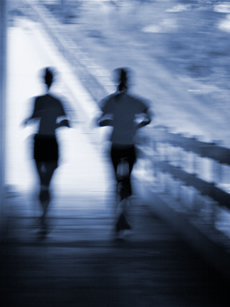
Training Tips
|

© Galina Barskaya - FOTOLIA
Most people run a race to see who is fastest. I run a race to see who has the most guts. Quote by- Steve Prefontaine
|
Training Tips |
Check with you doctor. Before you start get a check up with your GP. Be open and honest with him about your level of fitness and tell you doctor what type of race or distance you are planning on doing. If you are planning on a triathlon this is also a good time to check that your innoculations are up to date. Shoe mileage. Keep a note of how many miles you have put on your shoes. A good place to keep this is in a running log. The cushioning in the sole losses it effectiveness way before you wear out the soles, think about changing them at around the 350 to 500 mile mark . The lighter runners can get closer to the top end of the scale , whilst heavier runners like myself are a lot harder on the shoes and should change earlier to prevent injury. Wear what you are comfortable in. First of all you need to feel comfortable in what you train in. Choose ‘technical’ materials for your tops and shorts. Dri fit or coolmax are examples of technical materials which wick sweat away from your body and letting it evaporate quickly. One of the best tips I received for my first marathon, if you're a bigger runner wear a lycra short under a baggy running short to prevent chaffing. A running jacket or gilet is also advisable for the inclement British weather. A hat/cap and you are pretty much all set. Also some Brave soldier friction zone or vasaline may be of use for tender areas to prevent chaffing. Never wear new gear on race day. Make sure you have trained in what you wear on race day. This should reduce the chance of blisters of chaffing. I stupidly went against my own advice at the London Triathlon and had sore nipples for days after, not pleasant. Set yourself a goal. It is a lot easier to motivate myself if I have something to aim for. When I decided to run a marathon , I first set myself several milestones , a 5K race to get me going and to get a base level of fitness, I then moved up to longer distance races, finally finishing with the Chicago marathon. Run safely. Be seen, if you are running in the dark wear reflective clothing and a reflective or flashing armband, I wear a Nike Electrolite Safety Band. If listening to music keep it low so you can hear what is going on around you. If you are running in remote areas let someone know what route you are running. Wear or take some form of ID in case you have an accident. Get a good training plan. It is essential that in your enthusiasm to train for an event that you do not over train and injure yourself. The rule of thumb is never increase your speed or distance by more than 10% per week. Get a good training plan, see my training plan page for some resources for both free training plans or training plans for purchase. Most importantly stick to them and they work. Mix up your training. Fit in some speed training or hill running for performance improvements. Not every run should be long and slow. Keep a training log. It helps you stay motivated and is great to review how you are improving. It can be a simple pad, a spreadsheet or a software program that comes along with your speed and distance monitor Join a local running group/club. If you don't enjoy running alone the group camaraderie may keep you plodding along. Sometimes when you are in the middle of a good conversation you will forget that you are running. Also peer pressure and a little friendly competition is a good motivator. In addition, you will gain tips by running with others. Get a running partner. If you do not feel you are a running club sort of guy or girl, getting a running partner can get you out on those cold wet mornings. Prearrange your runs and then you are less likely to bail on your buddy. Run your own race. Don't get discouraged because you can't keep up with a running partner. Listen to your body and run at a pace that is comfortable for you. Take care of injuries. Don't train too hard while injured. To recover from an injury, use the R.I.C.E. method: Rest, Ice, Compression and Elevation. Don't run if you have an injury as you will only make it worse. Hydrate. Make sure that you drink when training and racing, Drink before ,during and after training sessions. Do not wait to feel thirsty before drinking as that is a sign that you have started to dehydrate. That said do not drown yourself either. Drink only what you are used to drinking. If you are doing something like the London Marathon and there are Lucozade stands through the race , in training try drinking some lucozade. It is not advised to try new sport drinks while on the race in case they upset you stomach. I prefer Taut as it tastes less synthetic and has no E numbers. Powerade runs a close second. But this is down to personal choice. In the same way you pick what lager, bitter or wine you like, try a wide range of products and flavours until you find something that works for you. more to come.....
|







